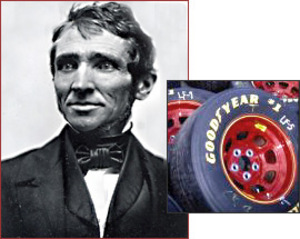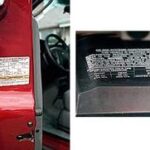The wheel was invented a very long time ago. But, the first rubber tire was invented in 1839 by Charles Goodyear. Up until this point, riding in cars was very uncomfortable because the older wheels made the ride rough.
In 1830, Charles Goodyear wanted to make a rubber product that the general public could put to use. He bought a truckload or raw rubber from a shoe factory and began his experiment to turn it into a complete solid. There was a small set back when Goodyear was sent to prison for not paying his debt from the rubber purchase. But, this did not stop him. While he was in prison he continued his experiments. When he was finally released, the product he had been working on had the consistency of gum. He then discovered that he was able to harden the rubber my mixing it with sulfur and then treating it with an acid gas. While tossing the rubber ball around it accidentally landed on top of a heated stove. The rubber began to change phase and melt, instead of scorching. This was a surprise to Goodyear. When he began to scrape the rubber off of the stove he realized it had hardened to the consistency he was aiming for. With the discovery of vulcanization, and the beginning of the industrial revolution in both Europe and North America, the tire evolved from a rubberized canvas protecting a rubber tube to a complex fabric, steel and elastomeric composition.
Vulcanization was invented by Charles Goodyear in 1839. Vulcanization is the process by which rubber is heated with sulfur to create a network of chemical cross-links. It produces a product that is not sticky like raw rubber, does not harden when cooled or soften much except with great heat, is elastic, and is highly resistant to abrasion. This process has been refined and enhanced since its creation. When vulcanized, natural rubber will form a three dimensional network of mono-, di-, and polysulfide bridges which gives the rubber its strength and elasticity. The cross-links that gives the tires these characteristics are not just sulfide linkages. They can be ionic clusters, polyvalent organic clusters, or polyvalent metallic ions. The process increases retractile force of the material, while decreasing the amount of permanent deformation occurring with the removal of a load. The process of vulcanization profoundly changes the molecular structure of rubber in terms of molecular weight. Hard rubber is vulcanized rubber in which thirty to fifty percent sulfur has been mixed in before heating. After the sulfur and rubber are mixed, the compound in usually placed in a mold and subjected to extreme heat and pressure. Vulcanization is done after the material has taken its final shape or form. The characterization of polymers starts with certain properties such as hysteresis. Hysteresis represents the history dependence of physical systems. If you push on something and it returns to its original form it is exhibiting hysteresis, in some sense. A material with no cross-links would remain permanently deformed.
There are many different types of vulcanization, with and without accelerators. Vulcanization without accelerators was normally used until 1906 when Oenslager found the first useful accelerator for use in the process. With no accelerator, the process used elemental sulfur at 8 parts per 100 parts of rubber and required a temperature of 140 degrees Celsius for five hours. The common reaction mechanism for unaccelerated vulcanization is the free-radical method. The reaction is a basic free-radical polymerization between isoprene and a sulfur radical. This method has a long curing time so it is not practical for use in a mass-production plant. Accelerators can greatly increase the rate of reaction so it is more commonly used except in specialty cases. Accelerated vulcanization can perform the same process at the same temperature but in about one to three minutes.
Goodyear continued his research for the means to make a better from of rubber without the stickiness. He discovered that rubber was charred and not melted by boiler sulfur. The famous vulcanizing process was discovered and was later patented in 1844. Vulcanization was to revolutionize the rubber industry. Goodyear was not much of a businessman and was unable to make a profit from his invention. He died a poor man on July 1, 1860. Charles Goodyear never saw a penny of the earnings from Goodyear Tire & Rubber Co. since the company was formed nearly 40 years after his death.






